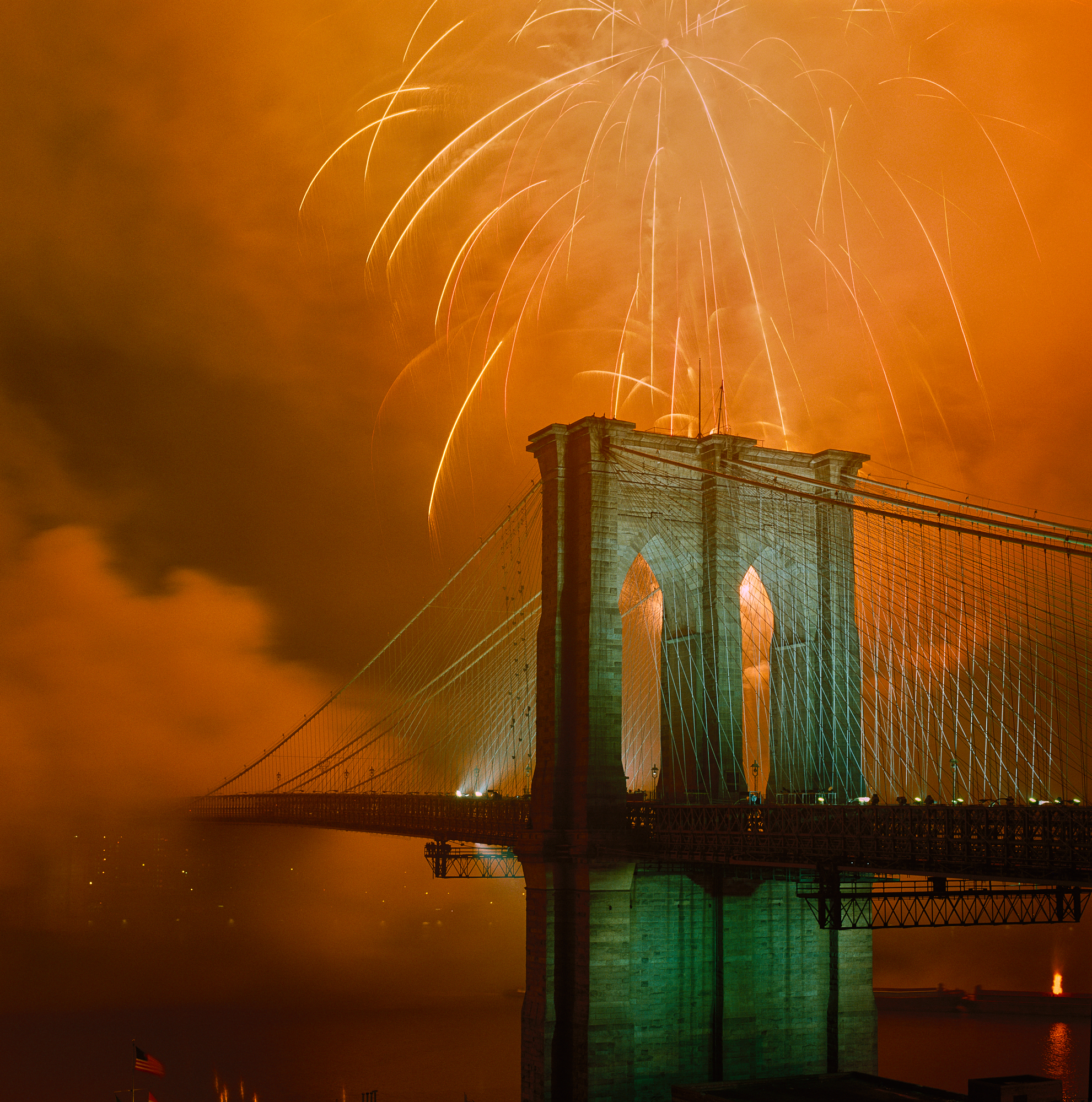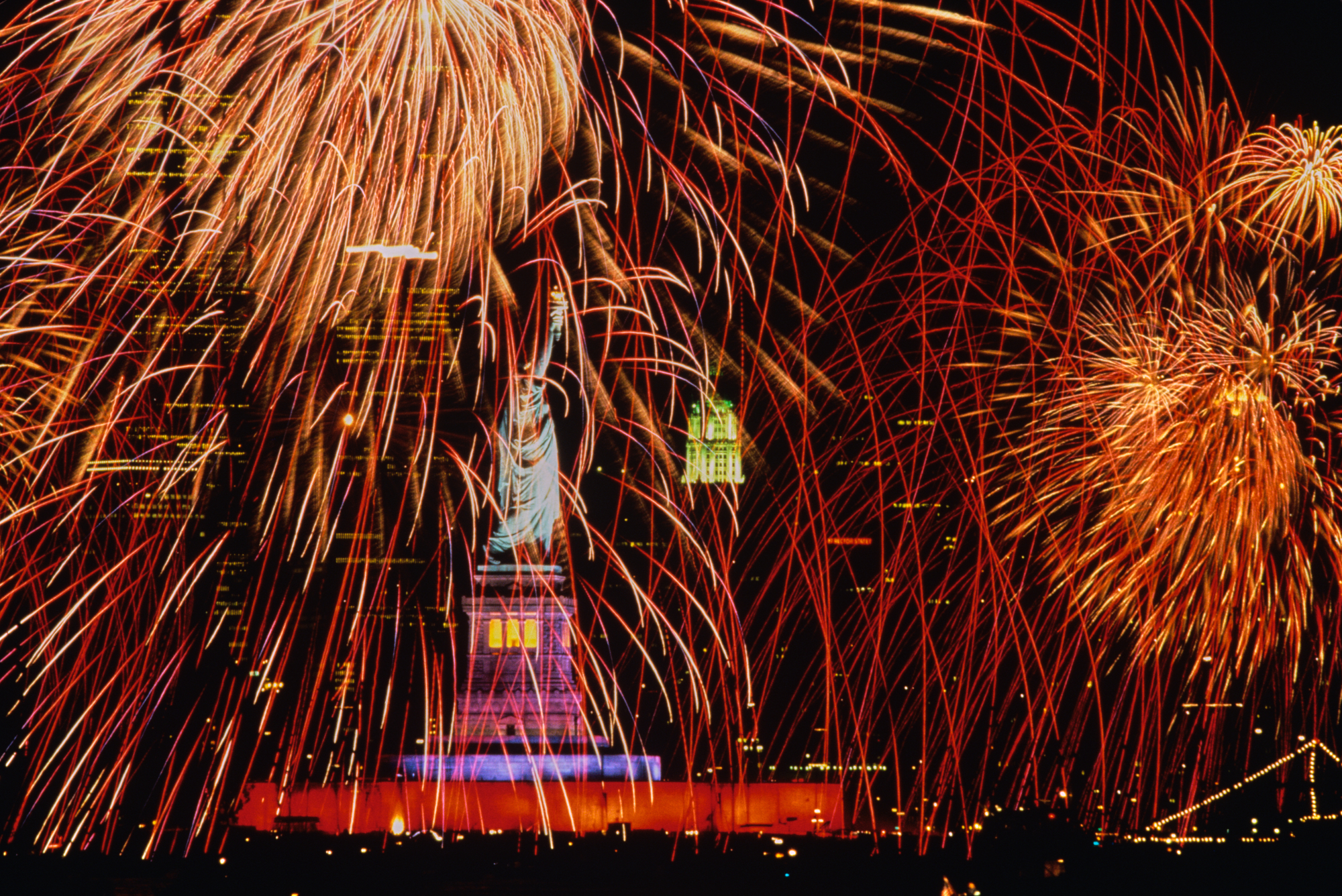It’s the Fourth of July Weekend! Break out the hot dogs, the beer, the ball game and the sunscreen. Not to mention the tripod and a cable release or maybe a fancier remote trigger.

For my contribution to notions about summer photos, I’m offering up, again, as a reprint, a blueprint for shooting fireworks pictures. The colors, shape, location and explosive nature of fireworks displays change, year to year. The techniques for shooting them do not. Forthwith……
Everybody loves to shoot fireworks. It has lots of connotations–holiday, patriotism, hot dogs, weekend, kids, family. Time to relax. Time to shoot some pictures.
Okay, make a checklist. Camera. Wide angle zoom. Telephoto zoom. Memory cards. Cable release or remote trigger, which, depending on the camera system, can be a radio, or perhaps bluetooth. (Fireworks are not the time for using interior camera triggering mechanisms, such as the intervalometer. You want to have complete control of the shutter and when it is tripped.) Spare camera battery. Tripod. Headlamp or flashlight, or even something like the cool little Maha Energy lantern to have handy as you make your way back in the dark. Bring your phone so you can monitor exposure time. Black card. (More on that later.)
That’s pretty much the photo kit. What else to think of? Rain gear, both for cameras and you. You can get fancy rain gear designed for cameras and lenses, or just use plastic bags and baggies. Couple of bungee cords to keep the bags on the camera if the wind starts whipping about. Water and power bars. You’ll be out there a while. Bug repellent. Comfortable clothing and shoes. The car might be quite a ways away, and you’ll be walking a fair piece. Advil. (Advil is always on my equipment list.)
Anything to do beforehand? You bet. Scout the location. Best to know what you are getting into, where they shoot the fireworks from, what the background will be like. How big will the display be? How long will it go for? Most fireworks displays are well over in a half hour or less, and if you are stumbling around in the crowd looking for a spot and trying to setup in the dark, you’ll just be starting to make decent exposures as they light up the sky with the crescendo and say goodnight till next year.
That’s right, next year. Most big shoot ’em ups are yearly events. Argh, the pressure!

So scout. Get your spot. Get there early. I mean early. Like, be the first car in the parking lot. Pack a soft cooler sling bag, throw an icepack in there, and know that in that bag is your sustenance till maybe late at night. For jobs like this, my music source and earphones are a must. Maybe a collapsible chair, and a small waterproof tarp. Think your way into this. What could go wrong? It’s a photo shoot, so the answer to that is, just about everything. Try to ensure success by envisioning the shot and the potential problems in making the shot before you walk out the door.
Like, do you need a permit to put your tripod down? Did you have to call the town about this adventure? Most likely not, but in this crazy, fraught world, photographers are often treated as being just this side of a recidivist offender, so it might be worth a phone call. And, speaking of tripods, this is an excursion for the best of tripods that you can manage. In my world, that means Gitzo. I use the heavier style of Systematic Gitzos for the the task of fireworks. Been relying on Gitzo camera platforms for over thirty years. Lifetime investment.
Okay, prepped and ready. Time to frame up the shot, which is a bit trickier than you might think. First off, when I shoot fireworks, I always get my frame, plus about 20%. I can always tighten up, but I want to give those fireworks room to play up there in the heavens. Frame too tight, you’ll have tracer lines of color going right out of the upper part of your picture, creating lines of interest that will pull your viewer’s eye right out with them.
So give them room to breathe and determine whether the shot is horizontal or vertical. Remember that most fireworks pix, if they are just of the explosions in the sky, are, at the end of the day, an exercise in color, nothing more. Even something as splashy as a pyrotechnic display needs context. So perhaps you can frame up with the object that is being celebrated, such as the Statue of Liberty. Or use the semi-silhouetted crowd as a foreground element. Or boats and bridges out in the water, with the water acting as a giant reflector board filled with color.
F/8 is a reasonable starting point. Some photogs I know go even lower on the aperture scale, down to f/11 or even f/16. Over time, you will find which settings work for you. (I used to take notes at the end of a fireworks job, just to keep myself tuned up for next year. No real need for that anymore, as the metadata tells you what works and what doesn’t.)
Set the shutter to bulb. This mode keeps the shutter open as long as the release button is pushed. But you are not physically pushing that button are you?! No! This is absolutely a job for a cable release or remote trigger. Nowadays, most cable releases have moved on from the electric cables which jack into the camera and activate the shutter. You now have infrared, bluetooth, radio…all manner of completely wireless solutions. Which is a good tactic. With lengthy exposures, even the slightest jiggle or vibration is the enemy, so you don’t want to be physically touching the camera shutter button.
This is important, because at f/8, the shutter will be open for a while, meaning anywhere from four to 10-15 seconds. (Remember if you have a foreground element in the picture, such as a monument, you have to make sure that lit up monument is exposed properly. In many ways, that foreground object will determine the length of your exposure.)
The variations that may occur with your framing are the reason to have at least a couple lenses with you. As mentioned above, two reasonable zooms, one wide and one telephoto, should do you fine.
Metering? Yikes, how do you meter a fast moving rocket moving through the black sky? The answer is, you don’t, really. This is a situation to shut off a bunch of the auto this and that on the camera, and go manual. Also, make sure to turn the flash off. Some cameras will read the darkness in in certain modes and activate that puppy. Ever see the opening of an Olympics, where thousands of people are using point and shoots, and their flashes are going off like crazy? Know what they’re lighting? The shoulder of the person in front of them. Fireworks, unless you are trying a radically different approach, are generally a no flash zone.
Okay, now set up manual. Fireworks are brighter than you might think, so you don’t need to open the lens really wide, which is a bit counter-intuitive, I know, ’cause it’s dark. But my experience with fireworks wide open is that you drain the color out of them. They’ll just register as a white streak. Be careful. You can over-expose fireworks quite easily.
Again, due to the brightness of fireworks, you can work at a reasonable or even low ISO. Something in the neighborhood of 100 or 200 will do fine. The faster your ISO, the shorter your shutter speeds, which will deprive you of recording those wonderful tracers of light into the sky.
Some shooters time the launch of the rockets and open their shutter accordingly, keeping it open for, say, 8-10 seconds, then closing down. This ensures that they will record the path of the pyrotechnic into the night sky, and it’s explosion. This is a fine approach. Give it a try.
Others use a black card. A black card is just that, a black card. Nothing mysterious or fancy. It can be a piece of black cardboard, or foam core board. Or it can just be an index card covered with black tape. (Be sure it is not shiny tape. That might pick up slivers of light and reflect it back into the lens. Use a matte black type of photo tape, often called gaffer tape.)
This way, you can keep your shutter open for very lengthy periods of time, and record multiple starbursts. You open the shutter, and shoot one explosion, then cover the lens with the card, and wait for the next. You can experiment with this trick, and produce really terrific results by layering multiple fireworks into one picture.
(Also, say, you have the Brooklyn Bridge as an architectural element in the foreground, and the proper exposure for it is f/8 at 10 seconds. This limits your fireworks shooting range, right? Gotta get the bridge right, so the exposure is a done deal. But, with the black card, if you are quick enough, you can uncover just the upper portion of the sky, while blocking the area of the lens which is recording the bridge. This is dicey. You have to move the card quickly, hovering it around where the bridge ends and the sky begins. If you have ever made a black and white print in the darkroom, think of this as burning and dodging right at the camera lens. Can’t keep the card static or it will create a hard line of obvious exposure change. It has to hover, quickly jiggling around that sky bridge borderline. If you pull this off right, you can keep your lens open for several batches of fireworks, extending over 20-30 seconds, filling the sky with color. But this is an experiment! Back yourself up by shooting some “straight” frames.)
With mirrorless technology and LCD’s, you can engage in experimentation with much more certainty than ever. You have the frame you just shot, right there, ready for your perusal. But be careful! Whilst you are checking your latest masterpiece, they are still flinging rockets into the sky, which you are missing. Don’t get over involved with the LCD! Keep shooting! (And yes, you can collect fireworks tracers all night and composite them together after the fact. But, do you really want to do that? Go for it, now, with the booms resounding in your ears and the colors streaking the sky, and the crowd ooohing and awwwing. Get it done, right there. You’ve prepared for a field adventure, not one to be completed in your basement in post-production. Personal opinion.)

Other bits and pieces: Don’t shoot all night long at one exposure. (If you are on bulb, you definitely won’t anyway.) But this is an occasion for bracketing, and shooting as many frames as possible. Also, shoot right away when they start! Fireworks displays can build up a lot of smoke over a series of explosions, and if you are smack in the wind pattern that blows that smoke towards your lens, you can end up thinking you’re shooting a war zone. So shoot immediately, and fast.
Have a wonderful, safe 4th of July, everybody! More tk…
The post Summer, the 4th of July, and Fireworks appeared first on Joe McNally Photography.






